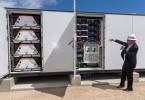Time to super-size: Utility-scale solar far better than rooftop
The recent achievements of the solar industry, both in Nevada and across the country, certainly deserve applause, not least for increasing consumer access to solar. Fueled by favorable incentives, public policies and innovative business models, the industry has sharply reduced the costs of solar electricity and achieved dramatic growth, although spurred by an increased desire among consumers for cleaner forms of energy. Nevada's 974 megawatts of installed solar make it fifth nationally for solar capacity, and the state ranked third in the U.S. for installations in 2014.
Despite this growth, solar remains an expensive alternative. If Nevada is going to make the sharp reductions in carbon emissions that many — including the federal government — advocate, while still enjoying healthy economic growth, solar generation will have to be greatly expanded. But it is important to obtain solar power as cost-effectively as possible, so that all customers can benefit.
In a recent study, an MIT team that I led presented a set of policy changes that would make it more likely that a solar-intensive future could be affordable. For starters, we call for a shift in federal research priorities toward emerging solar technologies that promise to cut total system costs. Large-scale energy storage should also be a research priority, since the output of solar facilities varies over time.
Importantly, we also call for basic changes in public policies that support solar generation. Because of solar's future potential and continuing progress, along with the current absence of a price on carbon emissions, support for solar should be maintained. Our current policies, however, are very inefficient; a close look reveals that we are paying a good deal more for solar electricity than we need to.
Let's start with a basic fact: residential solar systems are significantly more expensive per unit of capacity than utility-scale systems — we estimate about 70 percent more expensive on a levelized-cost basis. Moreover, residential roofs are often not optimally aligned for solar generation, and high levels of residential solar penetration generally require increased investments in distribution systems. Thus the most cost-effective path for future solar growth is to concentrate on utility-scale systems, and such systems have in fact accounted for more than 60 percent of recent solar growth.
Residential solar continues to grow robustly, in large part because it is heavily subsidized when compared to utility-scale solar. The main federal subsidy, the investment tax credit, has just been extended for an additional five years. Since the amount of the tax credit is directly proportional to system cost, residential systems — which are more expensive on a per-unit-of-capacity basis — receive larger tax credits per unit of capacity than utility-scale systems. This translates into even higher subsidies from taxpayers for rooftop solar than for other types of installations, such as utility-scale.
Up until recently, Nevada's net metering policies provided an additional and significant subsidy to residential solar that was not given to utility-scale solar or any other generation source. Retail rates, which residential generators received, were higher than the wholesale rates that utility-scale generators earn. The difference was a per-kilowatt-hour distribution charge that was designed to cover the largely fixed costs of the grid itself — the wires and related equipment. As more residential solar came on line and less electricity was purchased from the local utility, the distribution charge would have to be increased to cover those costs, and the burden of covering them would be shifted to the majority of consumers without rooftop solar. This amounted to spending subsidy dollars wastefully. Subsidizing the high-cost path to solar power more than lower-cost solar alternatives simply makes no economic or policy sense.
That's why the recent draft order approved by the Nevada Public Utilities Commission is a step in the right direction. By adjusting the fixed charges of customers with solar panels, this new rate structure reduces the cost shift from customers with solar to those without it, and addresses the problem of wasteful subsidies. It's also important to note that the utilities in Nevada will not see any revenue gained from the changes.
In order to promote the expansion of solar energy at a reasonable cost, our public policies must place a greater emphasis on rewarding the lowest-cost sources of solar electricity, not subsidizing the highest-cost sources. Current net metering policies do the exact opposite and end up imposing unfair costs on certain consumers.
Policymakers in Nevada should take this into consideration as they continue debate on the future of net metering and other solar-related policies in the state. The ultimate goal should be to treat all solar generators equally, and to reform net metering and other policies that unnecessarily raise power rates for everyone. This is the best way to ensure that more Nevada residents have access to clean and green solar energy.
— Richard Schmalensee is the Howard W. Johnson Professor of Management Emeritus and professor of economics emeritus at MIT, and former director of the MIT Center for Energy and Environmental Policy Research.




























